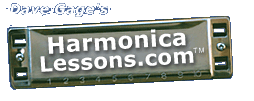First of all, this is a trick question. Each key signature represents 7 possible modes, of which two are considered common: the major and minor modes, or keys. Each major key has an associated minor key (C major and A minor, for instance), and the share the same pattern of sharps and flats!First, I'll tell you how I identify the major key assicuated with a key signature. Next, show how to determine if the song is actually in the
relative minor key.
I identify keys a little differently than my teachers taught me (those who know me won't be surprised by this!). I've memorized the cycle of 4ths and 5ths, as follows:
C G D A E B F# going sharp, and
C F Bb Eb Ab Db Gb going flat
I'll number these:
C G D A E B F#
0 1 2 3 4 5 6 sharps
C F Bb Eb Ab Db Gb
0 1 2 3 4 5 6 flats
So, if I see 3 sharps, I'll run through my list of sharps: G D A. 3 sharps is the key of A major.
If I see 2 flats, I think: F Bb. 2 flats is the key of Bb.
Whether you are in a major key or its relative minor can usually be determined by looking at the final (resolution) node of the melody. If the key signature is 0 sharps or flats, and the final note of the melody is a C, than the key is C major. If the final note of the melody is an A, than the key is A minor.
Here's another example. Suppose the key signature is 2 flats. If the melody ends on Bb, then the key is Bb major. If the melody ends on G, then the key is G minor.
If you're wondering what the "relative minor" is, it's the minor key of the 6th note of the major scale, with the tonic counting as the 1st (not 0th) note. Here's the scale of C major:
C D E F G A B
1 2 3 4 5 6 7
The 6th note is "A", so the relative minor is "A minor".
Another way to determine the relative minor is to go three keys sharper on the cycle of 4ths and 5ths (wrapping around the cycle appropriately).
What if you have a key signature, say 2 sharps, but the last note of the melody isn't a D (key of D major) or a B (key of B minor)? In some cases, this is simply a melody that doesn't resolve. You might hear this in movie music, where a melody line is interrupted short of resolution to add tension to the moment. On the other hand, you might have what is called a "modal" melody, which means a mode (key) other than the conventional major or minor keys. (By the way, some music purists may object to the way I'm bluring the distinction between "mode" and "key". Tough.) For example, if there are no sharps or flats, and the melody ends on a D, then the melody may be written in the mode of D dorian. The modes (keys) other than the normal major and minor keys are common in European folk music, such as, say, celtic music.
Craig Milo Rogers

 Rate
this topic
Rate
this topic